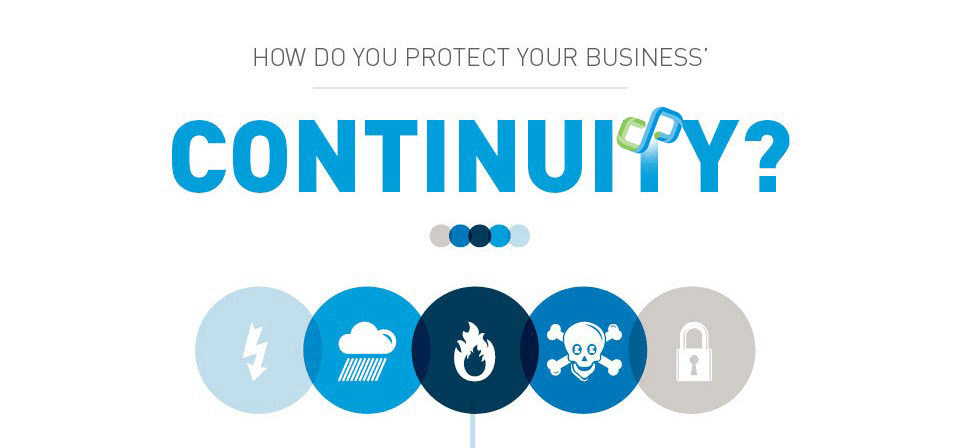
Protect your business by implementing a business continuity strategy that puts the necessary plan and technology in place to reduce downtime in the event a disaster strikes. Are your servers backed up? Is all your data stored on-site? Could your business weather a major equipment failure caused by a hard drive crash, flood, lightning strike, or even theft? Does all that equate to the loss of revenue and productivity?
Our team of experts create a detailed and appropriate strategy as well as conduct a risk assessment so that your employees can be working as soon as possible in the event of a disaster.

Business Impact Analysis (BIA)
This involves determining the operational and financial impact of a potential disaster or disruption, including loss of sales, credibility, compliance fines, legal fees, PR management, etc.
It also includes measuring the amount of financial/operational damage depending on the time of the year. A risk assessment should be conducted as part of the BIA to determine what kind of assets are actually at risk – including people, property, critical infrastructure, IT systems, etc.; as well as the probability and significance of possible hazards – including natural disasters, fires, mechanical problems, supply failure, cyber attacks; etc.
Mapping out your business model and determining where the interdependencies lie between the different departments and vendors within your company is also part of the BIA. The larger the organization, the more challenging it will be to develop a successful business continuity and disaster recovery plan. Sometimes organizational restructuring and business process or workflow realignment is necessary not only to create a business continuity/disaster recovery plan but also to maximize and drive operational efficiency.
Recovery Strategies
Analyzing your company’s most valuable data, that is data that directly leads to revenue, is key when determining what you need to backup and restore as part of your information technology (IT) disaster recovery plan.
Create an inventory of documents, databases and systems that are used on a day-to-day basis to generate revenue, and then quantify and match income with those processes as part of your recovery strategy/business impact analysis.
Aside from IT, a recovery strategy also involves personnel, equipment, facilities, a communication strategy and more in order to effectively recover and restore business operations.
Plan Development
Using information derived from the business impact analysis in conjunction with the recovery strategies, establish a plan framework. Documenting an IT disaster recovery plan is part of this stage.
As can be seen from the multiple steps within business continuity planning, disaster recovery is a subset within a larger overarching plan to keep a business running. It involves restoring and recovering IT infrastructure, including servers, networks, devices, data and connectivity.
A data backup plan involves choosing the right hardware and software backup procedures for your company, scheduling and implementing backups as well as checking/testing for accuracy.
Testing & Exercises
Develop a testing process to measure the efficiency and effectiveness of your plans, as well as how often to conduct tests. Part of this step involves establishing a training program and conducting training for your company/business continuity team.
Testing allows you to clearly define roles and responsibilities and improve communication within the team, as well as identify any weaknesses in the plans that require attention. This allows you to allocate resources as needed to fill the gaps and build up a stronger, more resilient plan.
DISASTER RECOVERY
As an integral part of business continuity plan development, creating an IT disaster recovery plan is essential to keep businesses running as they increasingly rely on IT infrastructure (networks, servers, systems, databases, devices, connectivity, power, etc.) to collect, process and store mission-critical data.
A disaster recovery plan is designed to restore IT operations at an alternate site after a major system disruption with long-term effects. After successfully transferring systems, the goal is to restore, recover, test affected systems and put them back in operation.
Your IT infrastructure is, in most cases, the lifeblood of your organization. When websites are down or patient data is unavailable due to hacking, natural disasters, hardware failure or human error, businesses cannot survive.
According to FEMA, a recovery strategy should be developed for each component:
- Physical environment in which data/servers are stored – data centers equipped with climate control, fire suppression systems, alarm systems, authorization and access security, etc.
- Hardware – Networks, servers, devices and peripherals.
- Connectivity – Fiber, cable, wireless, etc.
- Software applications – Email, data exchange, project management, electronic healthcare record systems, etc.
- Data and restoration
Identify the critical software applications and data, as well as the hardware required to run them. Additionally, determining your company’s custom recovery point and time objectives can prepare you for recovery success by creating guidelines around when data must be recovered.



